Lophophores - Study guides, Class notes & Summaries
Looking for the best study guides, study notes and summaries about Lophophores? On this page you'll find 15 study documents about Lophophores.
All 15 results
Sort by
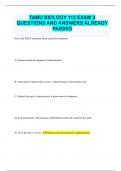
-
TAMU BIOLOGY 112 EXAM 3 QUESTIONS AND ANSWERS ALREADY PASSED
- Exam (elaborations) • 45 pages • 2024
- Available in package deal
-
- $11.49
- + learn more
TAMU BIOLOGY 112 EXAM 3 QUESTIONS AND ANSWERS ALREADY PASSED Select the TRUE statement about animal development: A.) Deuterostome development is indeterminate. B.) Mesoderm in protostomes arises as outpocketings of the primitive gut. C.) Radial cleavage is characteristic of protostome development. D) In deuterostomes, the blastopore ultimately becomes the mouth of the adult. E) All of the above are true. Deuterostome development is indeterminate. During embryogenesis o...

-
TAMU BIOLOGY 112 EXAM #3 Questions and Answers 100% Pass
- Exam (elaborations) • 33 pages • 2024
- Available in package deal
-
- $13.49
- + learn more
TAMU BIOLOGY 112 EXAM #3 Questions and Answers 100% Pass Select the TRUE statement about animal development: A.) Deuterostome development is indeterminate. B.) Mesoderm in protostomes arises as outpocketings of the primitive gut. C.) Radial cleavage is characteristic of protostome development. D) In deuterostomes, the blastopore ultimately becomes the mouth of the adult. E) All of the above are true. - Answer- Deuterostome development is indeterminate. During embryogenesis of diploblasti...

-
TAMU BIOLOGY 112 EXAM #3 Questions and Answers 100% Pass
- Exam (elaborations) • 33 pages • 2024
- Available in package deal
-
- $13.49
- + learn more
TAMU BIOLOGY 112 EXAM #3 Questions and Answers 100% Pass Select the TRUE statement about animal development: A.) Deuterostome development is indeterminate. B.) Mesoderm in protostomes arises as outpocketings of the primitive gut. C.) Radial cleavage is characteristic of protostome development. D) In deuterostomes, the blastopore ultimately becomes the mouth of the adult. E) All of the above are true. - Answer- Deuterostome development is indeterminate. During embryogenesis of diploblasti...

-
TAMU BIOLOGY 112 EXAM #3 Questions and Answers 100% Pass
- Exam (elaborations) • 33 pages • 2024
-
- $13.49
- + learn more
TAMU BIOLOGY 112 EXAM #3 Questions and Answers 100% Pass Select the TRUE statement about animal development: A.) Deuterostome development is indeterminate. B.) Mesoderm in protostomes arises as outpocketings of the primitive gut. C.) Radial cleavage is characteristic of protostome development. D) In deuterostomes, the blastopore ultimately becomes the mouth of the adult. E) All of the above are true. - Answer- Deuterostome development is indeterminate. During embryogenesis of diploblasti...
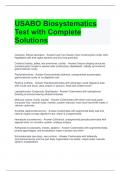
-
USABO Biosystematics Test with Complete Solutions
- Exam (elaborations) • 2 pages • 2024
-
- $12.99
- + learn more
USABO Biosystematics Test with Complete Solutions Calcarea, Silicea (sponges) - Answer-Lack true tissues; have choanocytes (collar cells-flagellated cells that ingest bacteria and tiny food particles) Cnidaria (hydras, jellies, sea anemones, corals) - Answer-Unique stinging structures (nematocysts) housed in special cells (cnidocytes); diploblastic, radially symmetrical, gastrovascular cavity Plathyhelminthes - Answer-Dorsoventrally flattened, unsegmented acoelomates; gastrovascular cavit...
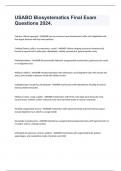
-
USABO Biosystematics Final Exam Questions 2024.
- Exam (elaborations) • 3 pages • 2024
-
Available in package deal
-
- $12.49
- + learn more
USABO Biosystematics Final Exam Questions 2024. Calcarea, Silicea (sponges) - ANSWER Lack true tissues; have choanocytes (collar cells-flagellated cells that ingest bacteria and tiny food particles) Cnidaria (hydras, jellies, sea anemones, corals) - ANSWER Unique stinging structures (nematocysts) housed in special cells (cnidocytes); diploblastic, radially symmetrical, gastrovascular cavity Plathyhelminthes - ANSWER Dorsoventrally flattened, unsegmented acoelomates; gastrovascular cavity ...
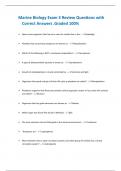
-
Marine Biology Exam 3 Review Questions with Correct Answers .Graded 100%
- Exam (elaborations) • 3 pages • 2024
-
- $5.49
- + learn more
Open ocean organisms that live at or near the surface live in the: - Epipelagic Plankton that are primary producers are known as: - Phytoplankton Which of the following is NOT a crustacean zooplankton? - Ctenophores A type of photosynthetic bacteria is known as: - Cyanobacteria Growth of phytoplankton is mostly controlled by: - Nutrients and light Organisms the spend only part of their life cycle as plankton are called? - Meroplankton Planktonic organism that float just beneath surf...

-
USABO Biosystematics Final Exam Questions With Correct Answers 2024.
- Exam (elaborations) • 3 pages • 2024
-
Available in package deal
-
- $10.49
- + learn more
USABO Biosystematics Final Exam Questions With Correct Answers 2024. Calcarea, Silicea (sponges) - ANSWER Lack true tissues; have choanocytes (collar cells-flagellated cells that ingest bacteria and tiny food particles) Cnidaria (hydras, jellies, sea anemones, corals) - ANSWER Unique stinging structures (nematocysts) housed in special cells (cnidocytes); diploblastic, radially symmetrical, gastrovascular cavity Plathyhelminthes - ANSWER Dorsoventrally flattened, unsegmented acoelomates; ...

-
Campbell Biology Chapter 33 Study Guide with Complete Solutions
- Exam (elaborations) • 13 pages • 2024
-
- $9.99
- + learn more
Campbell Biology Chapter 33 Study Guide with Complete Solutions Invertebrates - Answer️️ -Animals without a backbone. About 95% of known animal species. Calcarea and Silicea - Answer️️ -phylum that includes sponges; no symmetry, tissues, body cavity, organs, nervous system; basal animals; mostly marine; contain spicules; most are hermaphrodites; free-swimming during larval stage and sessile (non motile) as adults; suspension/filter feeders Suspention feeders - Answer️️ -small...
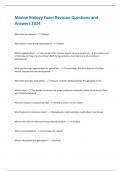
-
Marine Biology Exam Revision Questions and Answers 2024
- Exam (elaborations) • 2 pages • 2024
-
- $3.49
- + learn more
What class are mussels? - Bivalvia What doesn't show strong cephalization? - Jellyfish What is cephalization? - the concentration of sense organs, nervous control, etc., at the anterior end of the body, forming a head and brain, both during evolution and in the course of an embryo's development. What are the major requirements for animal life? - Gas exchange, Nutrition, disposal of cellular wastes, reproduction and development What best describes comb jellies? - They are creatures di...

That summary you just bought made someone very happy. Also get paid weekly? Sell your study resources on Stuvia! Discover all about earning on Stuvia


